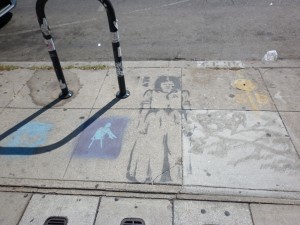At this point in my Pavement Graffiti project I’m thinking about maps – the formal and the informal, the fanciful and the accidental.
Two lovely books that I ordered arrived on my doorstep this week. The first is Kris Harzinski’s From here to there: a curious collection from the Hand Drawn Map Association. It contains the kind of mud maps that people draw for one another on the back of an envelope or on a page torn from a notebook. Harzinski is just as interested in the story behind the map as he is in the map itself. But he doesn’t use the term ‘mud map’. It was only while researching this blog post that I realised that this term, which I use from time to time, is Australian in origin.
The second book is The map as art: contemporary artists explore cartography by Katharine Harmon. There are 360 works reproduced here. Described on the back cover blurb as ‘a collection of visionary topographies and imaginary geographies’, these artworks are executed in many different media. Two I particularly liked featured map-like marks on the ground: Nina Katchdourian’s Moss Maps are ‘scrambled atlases’ of lichen on granite rocks; the Rock Maps of eight-year old artist Theodore Lamb are photographs of cracks in rocks.
 Lamb’s Rock Maps remind me of photographs I have taken of cracks in asphalt. They show up best after rain and this ‘map’, taken in Stanmore (Sydney), even includes a sky-coloured lake.
Lamb’s Rock Maps remind me of photographs I have taken of cracks in asphalt. They show up best after rain and this ‘map’, taken in Stanmore (Sydney), even includes a sky-coloured lake.
Â
Â
Â
Â
Â
Â
Â
Â
Â
 Last year I photographed a wonderful map drawn by a boy on the footpath outside his house in Rozelle. His play world grew each day.
Last year I photographed a wonderful map drawn by a boy on the footpath outside his house in Rozelle. His play world grew each day.















